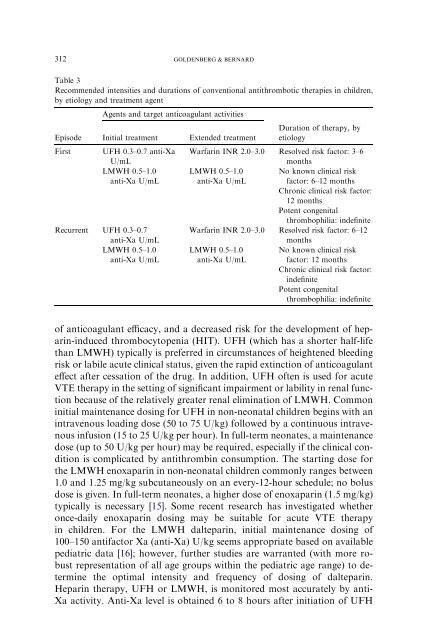Pediatric Clinics of North America - CIPERJ
Pediatric Clinics of North America - CIPERJ
Pediatric Clinics of North America - CIPERJ
You also want an ePaper? Increase the reach of your titles
YUMPU automatically turns print PDFs into web optimized ePapers that Google loves.
312 GOLDENBERG & BERNARD<br />
Table 3<br />
Recommended intensities and durations <strong>of</strong> conventional antithrombotic therapies in children,<br />
by etiology and treatment agent<br />
Agents and target anticoagulant activities<br />
Duration <strong>of</strong> therapy, by<br />
Episode Initial treatment Extended treatment etiology<br />
First UFH 0.3–0.7 anti-Xa<br />
U/mL<br />
Warfarin INR 2.0–3.0 Resolved risk factor: 3–6<br />
months<br />
LMWH 0.5–1.0<br />
anti-Xa U/mL<br />
LMWH 0.5–1.0<br />
anti-Xa U/mL<br />
No known clinical risk<br />
factor: 6–12 months<br />
Chronic clinical risk factor:<br />
12 months<br />
Potent congenital<br />
thrombophilia: indefinite<br />
Recurrent UFH 0.3–0.7<br />
anti-Xa U/mL<br />
Warfarin INR 2.0–3.0 Resolved risk factor: 6–12<br />
months<br />
LMWH 0.5–1.0<br />
anti-Xa U/mL<br />
LMWH 0.5–1.0<br />
anti-Xa U/mL<br />
No known clinical risk<br />
factor: 12 months<br />
Chronic clinical risk factor:<br />
indefinite<br />
Potent congenital<br />
thrombophilia: indefinite<br />
<strong>of</strong> anticoagulant efficacy, and a decreased risk for the development <strong>of</strong> heparin-induced<br />
thrombocytopenia (HIT). UFH (which has a shorter half-life<br />
than LMWH) typically is preferred in circumstances <strong>of</strong> heightened bleeding<br />
risk or labile acute clinical status, given the rapid extinction <strong>of</strong> anticoagulant<br />
effect after cessation <strong>of</strong> the drug. In addition, UFH <strong>of</strong>ten is used for acute<br />
VTE therapy in the setting <strong>of</strong> significant impairment or lability in renal function<br />
because <strong>of</strong> the relatively greater renal elimination <strong>of</strong> LMWH. Common<br />
initial maintenance dosing for UFH in non-neonatal children begins with an<br />
intravenous loading dose (50 to 75 U/kg) followed by a continuous intravenous<br />
infusion (15 to 25 U/kg per hour). In full-term neonates, a maintenance<br />
dose (up to 50 U/kg per hour) may be required, especially if the clinical condition<br />
is complicated by antithrombin consumption. The starting dose for<br />
the LMWH enoxaparin in non-neonatal children commonly ranges between<br />
1.0 and 1.25 mg/kg subcutaneously on an every-12-hour schedule; no bolus<br />
dose is given. In full-term neonates, a higher dose <strong>of</strong> enoxaparin (1.5 mg/kg)<br />
typically is necessary [15]. Some recent research has investigated whether<br />
once-daily enoxaparin dosing may be suitable for acute VTE therapy<br />
in children. For the LMWH dalteparin, initial maintenance dosing <strong>of</strong><br />
100–150 antifactor Xa (anti-Xa) U/kg seems appropriate based on available<br />
pediatric data [16]; however, further studies are warranted (with more robust<br />
representation <strong>of</strong> all age groups within the pediatric age range) to determine<br />
the optimal intensity and frequency <strong>of</strong> dosing <strong>of</strong> dalteparin.<br />
Heparin therapy, UFH or LMWH, is monitored most accurately by anti-<br />
Xa activity. Anti-Xa level is obtained 6 to 8 hours after initiation <strong>of</strong> UFH





